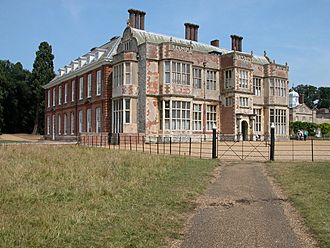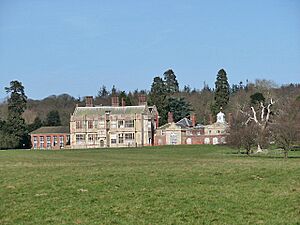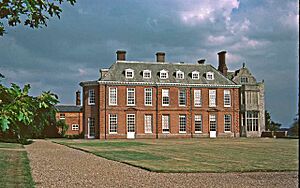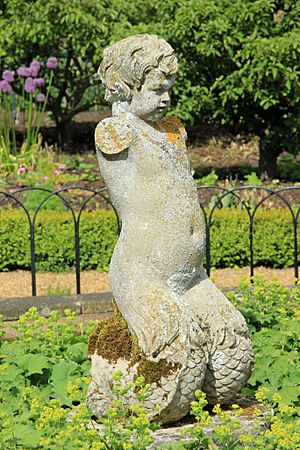Felbrigg Hall facts for kids
Quick facts for kids Felbrigg Hall |
|
|---|---|

View of Felbrigg Hall from the south, showing the Jacobean east wing, c. 1624 (right) and the west wing, c. 1680 (left)
|
|
| General information | |
| Type | Stately home |
| Location | Near Felbrigg village, South West of Cromer, Norfolk |
| Coordinates | 52°54′27″N 1°15′33″E / 52.9074°N 1.2593°E |
| Completed | Built in the 17th century |
| Owner | in the care of the National Trust |
Felbrigg Hall is a beautiful old house from the 1600s located near the village of Felbrigg in Norfolk, England. It is now looked after by the National Trust, a charity that protects historic places. The house is special because it still looks much like it did in the 17th century, showing off its Jacobean architecture (an old English style). Inside, you can see lovely Georgian designs from the 1700s.
Outside the hall, there is a walled garden, a special glass building called an orangery where citrus trees grow, and fruit orchards. The entire property, including the house and its grounds, was given to the National Trust in 1969 by its last private owner, Robert Ketton-Cremer. Felbrigg Hall is considered a very important historical building and is listed as Grade I on the National Heritage List for England. Most of the land around the house, known as Felbrigg Woods, is a special area for nature called a Site of Special Scientific Interest.
Contents
The History of Felbrigg Hall
Early Owners and Builders
The Felbrigg estate first belonged to the Felbrigg family. Later, it passed to the Wyndham family, who owned it for many centuries. One important member was Thomas Wyndham (died 1522), who was an advisor to King Henry VIII.
Another significant owner was John Wyndham (1558–1645). He is believed to be the person who built the main parts of Felbrigg Hall we see today. Over the 17th and 18th centuries, the Wyndham family added a lot more land to the estate. The last Wyndham to own Felbrigg was William Wyndham, who passed away in 1810.
The Last Private Owner
The last person to own Felbrigg Hall before it became a National Trust property was Robert Wyndham Ketton-Cremer. His brother, Richard, was supposed to inherit the estate, but he sadly died during the Second World War. Robert created a memorial for his brother in the woods behind the house.
Robert Wyndham Ketton-Cremer was also a writer. He wrote several books, especially about Norfolk, including a book about the history of Felbrigg Hall called Felbrigg: the Story of a House. Since Robert never married and had no children, he decided to leave the entire estate to the National Trust when he died in 1969. A part of the estate was later bought by Beeston Hall School.
Life at Felbrigg Hall
Christopher Mackie was the person who managed Felbrigg Hall for the National Trust until 1990. His wife, Mary Mackie, wrote three books about their experiences living and working there. These books give a fun look into what it was like to care for such a grand old house.
Felbrigg Hall Today
Today, the Felbrigg estate is very large, covering about 1,760 acres (which is about 7 square kilometers). This includes a big forest called Great Wood, which is about 520 acres (2.1 square kilometers) and helps protect the house from strong winds.
Visitors can explore the grounds using many marked walking paths that go through the estate. The Weavers' Way, a long-distance walking trail, also passes through Felbrigg. If you enjoy cycling, regional routes 33 and 30 of the National Cycle Network also run through the estate, making it a great place for outdoor activities.
The Gardens of Felbrigg Hall
The gardens at Felbrigg are designed in two different styles. The west garden looks like a typical Victorian "pleasure ground," which is a fancy garden designed for enjoyment. It is built around an 18th-century orangery. This garden plays with light and shadow, having neat lawns mixed with areas of dark bushes.
You can find many interesting plants from North America here, such as red oaks and western red cedars. There is also a meadow with a walled garden, which is a garden surrounded by high walls. The garden also features borders with different shrubs, a herbaceous border (a bed with non-woody plants), and more. The orchard has fruit trees that grow varieties of fruit known to have been in the garden during the 1800s. The gardens are also home to the National Collection of colchicums, which are beautiful autumn-flowering plants.
The gardens are also listed as Grade II* on the Register of Historic Parks and Gardens of special historic interest in England, showing their historical importance.
See also
 In Spanish: Felbrigg Hall para niños
In Spanish: Felbrigg Hall para niños




